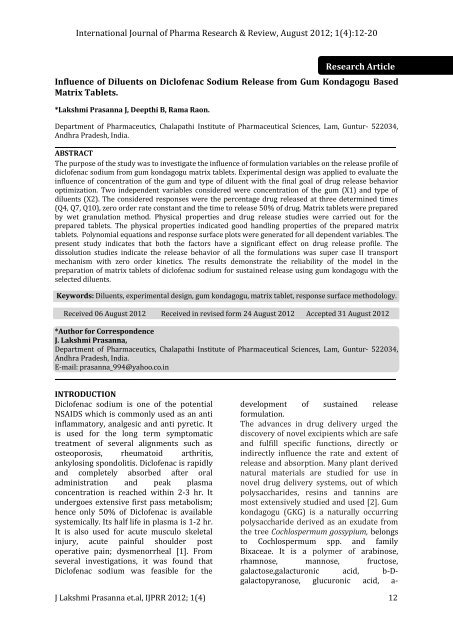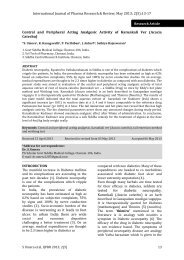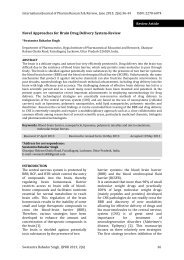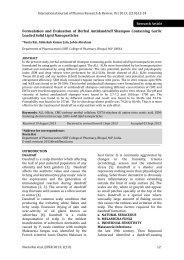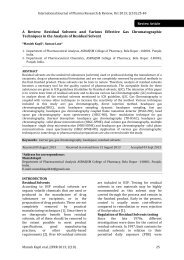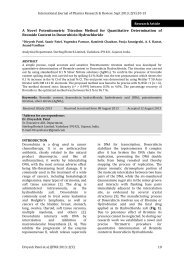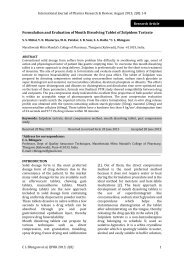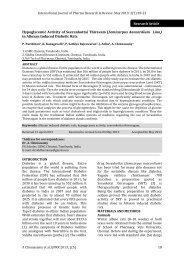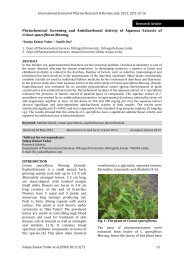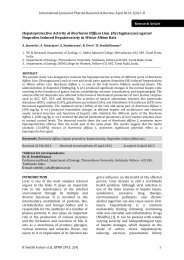International Journal of Pharma Research & Review, August 2012; 1 ...
International Journal of Pharma Research & Review, August 2012; 1 ...
International Journal of Pharma Research & Review, August 2012; 1 ...
You also want an ePaper? Increase the reach of your titles
YUMPU automatically turns print PDFs into web optimized ePapers that Google loves.
<strong>International</strong> <strong>Journal</strong> <strong>of</strong> <strong>Pharma</strong> <strong>Research</strong> & <strong>Review</strong>, <strong>August</strong> <strong>2012</strong>; 1(4):12-20<br />
<strong>Research</strong> Article<br />
Influence <strong>of</strong> Diluents on Dicl<strong>of</strong>enac Sodium Release from Gum Kondagogu Based<br />
Matrix Tablets.<br />
*Lakshmi Prasanna J, Deepthi B, Rama Raon.<br />
Department <strong>of</strong> <strong>Pharma</strong>ceutics, Chalapathi Institute <strong>of</strong> <strong>Pharma</strong>ceutical Sciences, Lam, Guntur- 522034,<br />
Andhra Pradesh, India.<br />
_________________________________________________________________________________________________________________________<br />
ABSTRACT<br />
The purpose <strong>of</strong> the study was to investigate the influence <strong>of</strong> formulation variables on the release pr<strong>of</strong>ile <strong>of</strong><br />
dicl<strong>of</strong>enac sodium from gum kondagogu matrix tablets. Experimental design was applied to evaluate the<br />
influence <strong>of</strong> concentration <strong>of</strong> the gum and type <strong>of</strong> diluent with the final goal <strong>of</strong> drug release behavior<br />
optimization. Two independent variables considered were concentration <strong>of</strong> the gum (X1) and type <strong>of</strong><br />
diluents (X2). The considered responses were the percentage drug released at three determined times<br />
(Q4, Q7, Q10), zero order rate constant and the time to release 50% <strong>of</strong> drug. Matrix tablets were prepared<br />
by wet granulation method. Physical properties and drug release studies were carried out for the<br />
prepared tablets. The physical properties indicated good handling properties <strong>of</strong> the prepared matrix<br />
tablets. Polynomial equations and response surface plots were generated for all dependent variables. The<br />
present study indicates that both the factors have a significant effect on drug release pr<strong>of</strong>ile. The<br />
dissolution studies indicate the release behavior <strong>of</strong> all the formulations was super case II transport<br />
mechanism with zero order kinetics. The results demonstrate the reliability <strong>of</strong> the model in the<br />
preparation <strong>of</strong> matrix tablets <strong>of</strong> dicl<strong>of</strong>enac sodium for sustained release using gum kondagogu with the<br />
selected diluents.<br />
Keywords: Diluents, experimental design, gum kondagogu, matrix tablet, response surface methodology.<br />
Received 06 <strong>August</strong> <strong>2012</strong> Received in revised form 24 <strong>August</strong> <strong>2012</strong> Accepted 31 <strong>August</strong> <strong>2012</strong><br />
*Author for Correspondence<br />
J. Lakshmi Prasanna,<br />
Department <strong>of</strong> <strong>Pharma</strong>ceutics, Chalapathi Institute <strong>of</strong> <strong>Pharma</strong>ceutical Sciences, Lam, Guntur- 522034,<br />
Andhra Pradesh, India.<br />
E-mail: prasanna_994@yahoo.co.in<br />
_________________________________________________________________________________________________________________________<br />
INTRODUCTION<br />
Dicl<strong>of</strong>enac sodium is one <strong>of</strong> the potential<br />
NSAIDS which is commonly used as an anti<br />
inflammatory, analgesic and anti pyretic. It<br />
is used for the long term symptomatic<br />
treatment <strong>of</strong> several alignments such as<br />
osteoporosis, rheumatoid arthritis,<br />
ankylosing spondolitis. Dicl<strong>of</strong>enac is rapidly<br />
and completely absorbed after oral<br />
administration and peak plasma<br />
concentration is reached within 2-3 hr. It<br />
undergoes extensive first pass metabolism;<br />
hence only 50% <strong>of</strong> Dicl<strong>of</strong>enac is available<br />
systemically. Its half life in plasma is 1-2 hr.<br />
It is also used for acute musculo skeletal<br />
injury, acute painful shoulder post<br />
operative pain; dysmenorrheal [1]. From<br />
several investigations, it was found that<br />
Dicl<strong>of</strong>enac sodium was feasible for the<br />
development <strong>of</strong> sustained release<br />
formulation.<br />
The advances in drug delivery urged the<br />
discovery <strong>of</strong> novel excipients which are safe<br />
and fulfill specific functions, directly or<br />
indirectly influence the rate and extent <strong>of</strong><br />
release and absorption. Many plant derived<br />
natural materials are studied for use in<br />
novel drug delivery systems, out <strong>of</strong> which<br />
polysaccharides, resins and tannins are<br />
most extensively studied and used [2]. Gum<br />
kondagogu (GKG) is a naturally occurring<br />
polysaccharide derived as an exudate from<br />
the tree Cochlospermum gossypium, belongs<br />
to Cochlospermum spp. and family<br />
Bixaceae. It is a polymer <strong>of</strong> arabinose,<br />
rhamnose, mannose, fructose,<br />
galactose,galacturonic acid, b-Dgalactopyranose,<br />
glucuronic acid, a-<br />
J Lakshmi Prasanna et.al, IJPRR <strong>2012</strong>; 1(4) 12
<strong>International</strong> <strong>Journal</strong> <strong>of</strong> <strong>Pharma</strong> <strong>Research</strong> & <strong>Review</strong>, <strong>August</strong> <strong>2012</strong>; 1(4):12-20<br />
Dglucose and b-D-glucose. It is used as a<br />
food additive and for sustained drug<br />
delivery [3,4]. A few works were reported<br />
on GK as mucoadhesive polymer, polymer<br />
in gastro retentive systems and also proved<br />
that it can be used as food additive as it is<br />
non toxic [5-7].<br />
MATERIALS AND METHODS<br />
Dicl<strong>of</strong>enac is obtained as a gift sample from<br />
Hetero Drugs, Hyderabad. Gum Kondagogu<br />
(GK) is procured from Girijan co-operastive<br />
corporation, Vizag. All other ingredients are<br />
<strong>of</strong> analytical grade.<br />
Preparation <strong>of</strong> matrix tablets<br />
Dicl<strong>of</strong>enac sodium matrix tablets were<br />
prepared by wet granulation method.<br />
Dicl<strong>of</strong>enac sodium (100 mg) was blended<br />
with appropriate quantities <strong>of</strong> GK (5 %, 10<br />
% and 15 %) and diluents (lactose, starch<br />
and MCC). This Premix blend was wet<br />
granulated with 3 % w/v solution <strong>of</strong> PVP K-<br />
90. The wet mass was passed through No.10<br />
Table 1: Composition <strong>of</strong> matrix tablets for experimental design.<br />
sieve. The wet granules were air dried at for<br />
one hour and the dried granules were<br />
sieved through No.16 sieve. Granules were<br />
evaluated for angle <strong>of</strong> repose, bulk density<br />
(BD) and tapped density (TD). Carr’s index<br />
(CI) and Hausner ratio were calculated<br />
using following equations [8]. After<br />
evaluation these granules were blended<br />
with lubricating agents (1% w/w<br />
magnesium stearate and 1% w/w talc) and<br />
compressed using 16 station rotary<br />
punching machine, equipped with flatfaced,<br />
round punches <strong>of</strong> 8-mm diameter.<br />
The composition <strong>of</strong> matrix tablets and pre<br />
compression parameters <strong>of</strong> the granules<br />
were given in (Table 1 and 2) respectively.<br />
Ingredients F1 F2 F3 F4 F5 F6 F7 F8 F9<br />
Dicl<strong>of</strong>enac<br />
sodium<br />
100 100 100 100 100 100 100 100 100<br />
GK 10 20 30 10 20 30 10 20 30<br />
Lactose 80 70 60 - - - - - -<br />
Starch - - - 80 70 60 - - -<br />
MCC - - - - - - 80 70 60<br />
PVP 6 6 6 6 6 6 6 6 6<br />
MS 2 2 2 2 2 2 2 2 2<br />
Talc 2 2 2 2 2 2 2 2 2<br />
Total weight. 200 200 200 200 200 200 200 200 200<br />
All the ingredients mentioned were in mg/tablet.<br />
Table 2: Pre compression parameters <strong>of</strong> formulation blends (mean ± S.D; n=3).<br />
Formulation<br />
code<br />
Angle <strong>of</strong><br />
repose (°)<br />
Bulk density<br />
(g/cc)<br />
Tapped<br />
density(g/cc)<br />
Carr’s index<br />
(%)<br />
Hausner<br />
ratio<br />
F1 27.70±0.88 0.508±0.004 0.570±0.004 10.9±0.010 1.12±0.000<br />
F2 26.30±1.37 0.499±0.007 0.531±0.008 5.89±0.005 1.06±0.000<br />
F3 25.11±1.52 0.437±0.007 0.471±0.009 7.14±0.183 1.07±0.002<br />
F4 27.56±0.92 0.433±0.006 0.472±0.007 8.32±0.192 1.14±0.096<br />
F5 28.73±1.72 0.507± 0.007 0.530±0.008 4.39 ±0.026 1.04±0 .00<br />
J Lakshmi Prasanna et.al, IJPRR <strong>2012</strong>; 1(4) 13
<strong>International</strong> <strong>Journal</strong> <strong>of</strong> <strong>Pharma</strong> <strong>Research</strong> & <strong>Review</strong>, <strong>August</strong> <strong>2012</strong>; 1(4):12-20<br />
F6 28.95±1.41 0.399±0.002 0.428±0.002 6.76±0.046 1.07±0.000<br />
F7 28.53±0.69 0.502±0.004 0.533±0.004 5.86±0.057 1.06±0.002<br />
F8 27.49±1.39 0.481± 0.004 0.560± 0.005 13.98±0.108 1.16±0.001<br />
F9 27.63±1.34 0.402±0.004 0.442±0.005 8.96±0.160 1.09±0.002<br />
Evaluation <strong>of</strong> formulated matrix tablets<br />
The prepared matrix tablets were evaluated<br />
for hardness, friability, thickness,<br />
uniformity <strong>of</strong> the weight and content<br />
uniformity. Hardness was determined by<br />
using Pfizer hardness tester. Friability was<br />
determined using Roche friability testing<br />
apparatus. Thickness was measured using<br />
vernier calipers. Uniformity <strong>of</strong> the weight<br />
and content uniformity were performed<br />
according to the I.P method [9, 10].The<br />
results were reported in (Table 3).<br />
Table 3: Physical characteristics and drug content <strong>of</strong> the matrix tablets (mean ± S.D; n=3).<br />
Formulation<br />
code<br />
Hardness<br />
(Kg/cm 2)<br />
Friability<br />
(%)<br />
Drug content<br />
(%)<br />
Tensile<br />
strength<br />
Average<br />
weight (mg)<br />
F1 6.80 ± 0.00 0.35 101.47±0.90 18.02±0.00 198±0.001<br />
F2 7.26 ± 0.11 0.35 100.88±0.92 19.61±0.53 202±0.001<br />
F3 7.60 ± 0.20 0.45 102.64±0.72 20.14±0.53 199±0.001<br />
F4 6.80 ± 0.20 0.35 99.41±1.475 18.02±0.53 198±0.001<br />
F5 7.40 ± 0.20 0.35 99.11±1.045 19.61±0.53 200±0.001<br />
F6 6.80 ± 0.20 0.51 97.35±0.836 18.02±0.53 201±0.001<br />
F7 6.73 ± 0.11 0.45 99.7±0.830 17.84±0.30 199±0.001<br />
F8 7.06 ± 0.11 0.43 97.94±1.020 18.72±0.305 198±0.001<br />
F9 6.93 ± 0.11 0.42 102.05±0.975 18.73±0.30 199±0.001<br />
Drug release studies<br />
The in vitro drug release studies were<br />
assessed by USP type II dissolution<br />
apparatus at 50 rpm in 900 ml <strong>of</strong> 0.1N HCl<br />
for first 2 hours and the phosphate buffer<br />
pH 6.8 from 3 to 10 hours, maintained at<br />
37°C ± 0.5°C.An aliquot (5ml) was<br />
withdrawn at specific time intervals and<br />
replaced with the same volume <strong>of</strong> pre<br />
warmed fresh dissolution medium. The<br />
samples withdrawn were filtered through<br />
Whatman filter paper (No.1) and drug<br />
content in each sample was analyzed by UVvisible<br />
spectrophotometer at 276 nm. The<br />
dissolution studies were carried out in<br />
triplicate. The amount <strong>of</strong> drug present in<br />
the sample was calculated with the help <strong>of</strong><br />
appropriate calibration curve constructed<br />
from reference standards. Dissolution<br />
pr<strong>of</strong>iles for various formulations were<br />
depicted in (Fig 1A, 1B and 1C).<br />
Release Kinetics<br />
To analyze the mechanism <strong>of</strong> drug release<br />
from the matrix tablets, the release data<br />
was fitted into various mathematical<br />
models viz., Zero order, first order and<br />
Highuchi equation [11]. the dissolution data<br />
was also fitted to the well known<br />
experimental equation (Koresmeyer’s<br />
Peppas equation), which is <strong>of</strong>ten used to<br />
describe the drug release behavior from<br />
polymer systems [12].<br />
Where, Mt is the amount <strong>of</strong> drug release at<br />
time t, Mf is the amount <strong>of</strong> drug release after<br />
infinite time; K is a release rate constant<br />
incorporating structural and geometrical<br />
characteristics <strong>of</strong> the tablet and n is the<br />
differential exponent indicative <strong>of</strong> the<br />
mechanism <strong>of</strong> drug release.<br />
J Lakshmi Prasanna et.al, IJPRR <strong>2012</strong>; 1(4) 14
Cumulative %drug released<br />
<strong>International</strong> <strong>Journal</strong> <strong>of</strong> <strong>Pharma</strong> <strong>Research</strong> & <strong>Review</strong>, <strong>August</strong> <strong>2012</strong>; 1(4):12-20<br />
60<br />
50<br />
40<br />
30<br />
20<br />
10<br />
0<br />
0 5 10 15<br />
Time (h)<br />
F4 F5 F6<br />
Figure 1B: In vitro release pr<strong>of</strong>ile <strong>of</strong> matrix<br />
tablets containing starch as diluent<br />
To clarify the release exponent for the<br />
different batches <strong>of</strong> matrix tablets, the log<br />
value <strong>of</strong> %drug was plotted against log time.<br />
A value <strong>of</strong> n=0.45 indicates Fickian (case I)<br />
release; >0.45 but 0.89 indicates super<br />
case II type <strong>of</strong> release. Case II gradually<br />
refers to the erosion <strong>of</strong> the polymeric chain<br />
and anomalous transport (non- Fickian)<br />
refers to a combination <strong>of</strong> both diffusion<br />
and erosion controlled drug release [13].<br />
Mean dissolution time (MDI) was calculated<br />
for dissolution data using the following<br />
equation [14].<br />
Cumulative %drug released<br />
100<br />
80<br />
60<br />
40<br />
20<br />
0<br />
Cumulative %drug released<br />
Where n= release exponent and K= release<br />
rate constant.<br />
Experimental design and data analysis<br />
A 3 2 factorial design was employed to study<br />
the effect <strong>of</strong> the gum and their<br />
concentration on the release rate <strong>of</strong><br />
dicl<strong>of</strong>enac sodium matrix tablets. The levels<br />
<strong>of</strong> the two factors were selected on the basis<br />
<strong>of</strong> the preliminary studies carried out<br />
before implementing the factorial design.<br />
The percent <strong>of</strong> drug release in 4 thh (Q4), 7 thh<br />
(Q7), 10 thh (Q10), time to release 50% drug<br />
(t50%) and zero order rate constant (K0)<br />
were taken as response variables. The<br />
factors, levels and the experimental runs<br />
with their factors combination were given<br />
J Lakshmi Prasanna et.al, IJPRR <strong>2012</strong>; 1(4) 15<br />
70<br />
60<br />
50<br />
40<br />
30<br />
20<br />
10<br />
0<br />
0 5 10 15<br />
Time (h)<br />
F7 F8 F9<br />
Figure 1C: In vitro release pr<strong>of</strong>ile <strong>of</strong> matrix<br />
tablets containing MCC as diluent<br />
containing lactose as diluent<br />
0 5 10 15<br />
Time (h)<br />
F1 F2 F3<br />
Figure 1A: In vitro release pr<strong>of</strong>ile <strong>of</strong> matrix<br />
tablets<br />
containing lactose as diluent
<strong>International</strong> <strong>Journal</strong> <strong>of</strong> <strong>Pharma</strong> <strong>Research</strong> & <strong>Review</strong>, <strong>August</strong> <strong>2012</strong>; 1(4):12-20<br />
in (Table 5 and 6) respectively. The<br />
response surface graphs and mathematical<br />
models were obtained from DOE s<strong>of</strong>tware.<br />
The effect <strong>of</strong> formulation variables on the<br />
response variables were statically<br />
evaluated using a commercially available<br />
s<strong>of</strong>tware package design <strong>of</strong> Experiments®<br />
8.0 (design expert). The fitting <strong>of</strong> an<br />
empirical polynomial equation to the<br />
experimental results facilitates the<br />
evaluation <strong>of</strong> the responses. The general<br />
polynomial equation is as follows:<br />
Table 4: Mathematical modeling <strong>of</strong> the dissolution data.<br />
Y = b0 + b1 X1 + b2 X2 + b12 X1 X2 + b11 X1 2 + b22<br />
X2 2<br />
Where Y is the dependent variable, b0 is the<br />
arithmetic mean response on nine runs and<br />
b1 is the estimated coefficient for factor X1.<br />
The main effects (X1, X2) represent the<br />
average values <strong>of</strong> changing one factor at a<br />
time from its low to high value. The<br />
interaction terms (X1X2) show how the<br />
response changes when two factors are<br />
changed simultaneously. The polynomial<br />
terms (X1 2 and X2 2) are included to<br />
investigate nonlinearity.<br />
Code Zero order First order Higuchi KorsemeyerPeppas<br />
K0(mg/h) r K1(h-1) r Kh(h-0.5) R Kp(h-n ) r n<br />
F1 7.83 0.981 0.085 0.954 15.11 0.857 1.177<br />
F2 5.33 0.979 0.048 0.921 9.67 0.801 1.177<br />
F3 2.42 0.948 0.025 0.96 5.48 0.839 1.013<br />
F4 4.71 0.949 0.062 0.923 1.75 0.809 1.306<br />
F5 3.12 0.946 0.036 0.933 7.77 0.804 1.967<br />
F6 1.92 0.97 0.023 0.97 4.84 0.843 2.992<br />
F7 7.45 0.971 0.126 0.908 18.78 0.844 2.074<br />
F8 6.27 0.962 0.092 0.929 15.75 0.83 1.339<br />
F9 5.29 0.963 0.071 0.936 13.25 0.828 1.061<br />
Table 5: Factors and levels <strong>of</strong> the experimental design<br />
J Lakshmi Prasanna et.al, IJPRR <strong>2012</strong>; 1(4) 16<br />
T 50%<br />
(h)<br />
0.97<br />
5 1.98 6.37<br />
0.99<br />
5 1.55 9.36<br />
0.97<br />
8 1.33 20.6<br />
0.99<br />
5 1.88<br />
0.99<br />
8 1.88<br />
0.99<br />
1 1.88<br />
10.6<br />
1<br />
16.0<br />
2<br />
26.0<br />
4<br />
0.99<br />
5 1.62 6.71<br />
0.99<br />
3 1.74 7.97<br />
0.99<br />
7 1.85 9.45<br />
Factor/ Level -1 0 +1<br />
X1 (Concentration <strong>of</strong> the gum) 5% 10% 15%<br />
X2 (type <strong>of</strong> diluent) Lactose Starch MCC
Design-Expert® S<strong>of</strong>tware<br />
Factor Coding: Actual<br />
Q4<br />
Design points above predicted value<br />
Design points below predicted value<br />
X1 = A: Gum concentration<br />
X2 = B: Type <strong>of</strong> diluent<br />
<strong>International</strong> <strong>Journal</strong> <strong>of</strong> <strong>Pharma</strong> <strong>Research</strong> & <strong>Review</strong>, <strong>August</strong> <strong>2012</strong>; 1(4):12-20<br />
Table 6: Dissolution characteristics <strong>of</strong> formulations in a 3 2 full factorial design<br />
Trail no Formulation<br />
code<br />
Q 4<br />
20<br />
15<br />
10<br />
5<br />
0<br />
1.00<br />
0.50<br />
B: Type <strong>of</strong> diluent<br />
0.00<br />
-0.50<br />
Design-Expert® S<strong>of</strong>tware<br />
Factor Coding: Actual<br />
Q7<br />
Design points above predicted value<br />
Design points below predicted value<br />
X1 = A: Gum concentration<br />
X2 = B: Type <strong>of</strong> diluent<br />
Figure 2A: Response surface plot <strong>of</strong><br />
tablet formulations after 4 hours<br />
dissolution<br />
Design-Expert® S<strong>of</strong>tware<br />
Factor Coding: Actual<br />
Q10<br />
Design points above predicted value<br />
Design points below predicted value<br />
X1 = A: Gum concentration<br />
X2 = B: Type <strong>of</strong> diluent<br />
-1.00 -1.00<br />
Q 1 0<br />
-0.50<br />
0.00<br />
0.50<br />
A: Gum concentration<br />
100<br />
80<br />
60<br />
40<br />
20<br />
1.00<br />
0.50<br />
B: Type <strong>of</strong> diluent<br />
0<br />
Coded factor<br />
levels<br />
0.00<br />
1.00<br />
-0.50<br />
-1.00 -1.00<br />
Q 7<br />
Figure 2B: Response surface plot <strong>of</strong><br />
tablet formulations after 7 hours<br />
dissolution<br />
J Lakshmi Prasanna et.al, IJPRR <strong>2012</strong>; 1(4) 17<br />
60<br />
50<br />
40<br />
30<br />
20<br />
10<br />
1.00<br />
0.50<br />
B: Type <strong>of</strong> diluent<br />
-0.50<br />
0.00<br />
0.00<br />
0.50<br />
-0.50<br />
A: Gum concentration<br />
Figure 2C: Response surface plot <strong>of</strong><br />
tablet formulations after 10 hours<br />
dissolution<br />
Percentage drug<br />
released<br />
X1 X2 Q4 Q7 Q9<br />
1.00<br />
-1.00<br />
-1.00<br />
-0.50<br />
Zero<br />
order<br />
rate<br />
constant<br />
1 F1 -1 -1 19.87 42.37 63.11 7.837 6.37<br />
2 F2 0 -1 9.6 22.47 48.6 5.337 9.36<br />
3 F3 1 -1 4.23 15.24 23.4 2.427 20.6<br />
4 F4 -1 0 11.8 33.24 55.42 4.71 10.61<br />
5 F5 0 0 7.94 19.61 39.15 3.12 16.02<br />
6 F6 1 0 5.71 13.36 20.75 1.92 26.04<br />
7 F7 -1 1 19.48 50.87 82.32 7.45 6.71<br />
8 F8 0 1<br />
14.73 44.87 68.1 6.27 7.97<br />
9 F9 1 1 13.91 37.47 59.92 5.29 9.45<br />
0.00<br />
0.50<br />
1.00<br />
A: Gum concentration<br />
T50%
esign-Expert® S<strong>of</strong>tware<br />
actor Coding: Actual<br />
o<br />
Design points above predicted value<br />
Design points below predicted value<br />
1 = A: Gum concentration<br />
2 = B: Type <strong>of</strong> diluent<br />
K o<br />
8<br />
7<br />
6<br />
1.00<br />
<strong>International</strong> <strong>Journal</strong> <strong>of</strong> <strong>Pharma</strong> <strong>Research</strong> & <strong>Review</strong>, <strong>August</strong> <strong>2012</strong>; 1(4):12-20<br />
0.50<br />
B: Type <strong>of</strong> diluent<br />
5<br />
4<br />
3<br />
2<br />
1<br />
0.00<br />
-0.50<br />
-1.00 -1.00<br />
Figure 2D: Response surface plot <strong>of</strong><br />
tablet formulations showing the effect<br />
<strong>of</strong> polymer on zero order rate<br />
constant<br />
-0.50<br />
0.00<br />
0.50<br />
A: Gum concentration<br />
1.00<br />
Design-Expert® S<strong>of</strong>tware<br />
Factor Coding: Actual<br />
T50%<br />
Design points above predicted value<br />
Design points below predicted value<br />
X1 = A: Gum concentration<br />
X2 = B: Type <strong>of</strong> diluent<br />
Figure 2E: Response surface plot <strong>of</strong><br />
tablet formulations showing the effect<br />
<strong>of</strong> polymer on T50%<br />
J Lakshmi Prasanna et.al, IJPRR <strong>2012</strong>; 1(4) 18<br />
T 5 0 %<br />
30<br />
25<br />
20<br />
15<br />
10<br />
5<br />
0<br />
1.00<br />
0.50<br />
0.00<br />
B: Type <strong>of</strong> diluent<br />
-0.50<br />
-1.00 -1.00<br />
-0.50<br />
0.00<br />
0.50<br />
1.00<br />
A: Gum concentration<br />
Table 7: Summary <strong>of</strong> the regression output <strong>of</strong> significant factors for the measured<br />
responses<br />
Parameters Coefficients <strong>of</strong> regression parameters<br />
b0 b1 b2 b12 b11 b22 R 2<br />
Q4 7.32 -4.55 2.40 2.52 1.74 5.15 0.9692<br />
Q7 20.00 -10.07 8.8 3.43 3.11 13.48 0.9889<br />
Q10 39.19 -16.13 12.54 4.33 -1.13 19.13 0.9917<br />
K0 3.23 -1.73 0.57 0.81 0.03 2.52 0.9891<br />
T50% 16.10 5.40 -2.03 -2.87 2.18 -7.48 0.9429<br />
Table 8: Analysis <strong>of</strong> variance for dependent variables in factorial design<br />
For Q4<br />
Regression SS DF MS F value<br />
Treatment 354.18 5 70.84 9.90<br />
Residual 21.47 3 7.16<br />
Total 375.64 8<br />
For Q7<br />
Treatment 35.15 5 7.03 54.33<br />
Residual 0.39 3 0.13<br />
Total 35.54 8<br />
For Q10<br />
Treatment 3314.08 5 662.82 71.82<br />
Residual 27.68 3 9.23<br />
Total 3341.76 8<br />
K0<br />
Treatment 1508.48 5 301.70 53.60<br />
Residual 16.88 3 5.63<br />
Total 1525.36 8<br />
T50<br />
Treatment 243.41 5 48.68 18.88<br />
Residual 7.74 3 2.58<br />
Total 251.15 8
<strong>International</strong> <strong>Journal</strong> <strong>of</strong> <strong>Pharma</strong> <strong>Research</strong> & <strong>Review</strong>, <strong>August</strong> <strong>2012</strong>; 1(4):12-20<br />
RESULTS AND DISCUSSION<br />
The granules <strong>of</strong> dicl<strong>of</strong>enac sodium matrix<br />
tablets were prepared by wet granulation<br />
method according to the formula given in<br />
(Table 1). The formulation blends were<br />
characterized with respect to angle <strong>of</strong><br />
repose, BD and TD. The angle <strong>of</strong> repose was<br />
less than 29° indicates satisfactory flow<br />
behavior. Physical characteristics <strong>of</strong> the<br />
prepared granules were given in (Table 2).<br />
The matrix tablets were evaluated for<br />
hardness, friability, content uniformity,<br />
uniformity <strong>of</strong> weight, tensile strength and in<br />
vitro drug release studies. The hardness <strong>of</strong><br />
the tablets in all the batches was found to<br />
be in the range <strong>of</strong> 6.73 – 7.60 Kg/cm 2. The<br />
friability <strong>of</strong> all the formulations was less<br />
than 1%. The drug content was found to be<br />
uniform for all the batches <strong>of</strong> tablets<br />
prepared and was found to be within<br />
99±2% <strong>of</strong> labeled claim. The tensile<br />
strength <strong>of</strong> the tablet ranges from 17.84 -<br />
20.14. Evaluation data <strong>of</strong> the matrix tablets<br />
were given in (Table 3). The hardness and<br />
friability values indicated good handling<br />
properties <strong>of</strong> the prepared matrix tablets.<br />
The prepared matrix tablets were also<br />
studied to in vitro drug release studies.<br />
(Table 4) indicates the data analysis <strong>of</strong><br />
release pr<strong>of</strong>iles according to different<br />
kinetic models. Drug release from the<br />
matrix tablets was found inversely<br />
proportional to the concentration the gum<br />
and depends on type <strong>of</strong> diluent. . The drug<br />
release fitted zero order kinetics and<br />
mechanism <strong>of</strong> release is by diffusion. The<br />
dissolution pr<strong>of</strong>ile <strong>of</strong> matrix tablets was<br />
depicted in (Fig. 1 A-C).<br />
In vitro release data obtained from<br />
formulations prepared were fitted to<br />
multiple linear regression analysis.<br />
Mathematical relationships generated<br />
using multiple linear regression analysis<br />
(MLRA) for the studied response variables<br />
are expressed as equations and were<br />
represented below.<br />
The factors selected are concentration <strong>of</strong><br />
the gum (5%, 10% and 15%) and type <strong>of</strong><br />
diluents (lactose, starch and MCC). The<br />
responses selected are drug release at 4 th<br />
(Q4), 7 thh (Q7), 10 th h (Q10), t50% and K0. The<br />
fitted polynomial equations are given below<br />
and the regression coefficients are given in<br />
(Table 7).<br />
Q4 = +7.32-4.55 X1 +2.40 X2 +2.52 X1X2 +1.74<br />
X1 2 +5.15 X2 2<br />
Q7 = +20.00-10.07 X1 +8.8 X2 +3.43 X1X2<br />
+3.11 X1 2 +13.48 X2 2<br />
Q10 = +39.19-16.13 X1 +12.54 X2 +4.33 X1X2 -<br />
1.13 X1 2 +19.13 X2 2<br />
K0 = +3.23-1.73 X1 +0.57 X2 +0.81X1X2<br />
+0.030 X1 2 +2.52 X2 2<br />
T50% = +16.10+5.40 X1 -2.03 X2 -2.87 X1X2<br />
+2.18 X1 2 -7.48 X2 2<br />
The high levels <strong>of</strong> correlation coefficients<br />
for the dependent variables indicate a good<br />
fit i.e., good agreement between the<br />
dependent and independent variables. The<br />
polynomial equation can be used to draw a<br />
conclusion after considering the magnitude<br />
<strong>of</strong> the coefficient and the mathematical sign<br />
it carries ( positive or negative). Positive<br />
sign before a factor in polynomial equations<br />
represents that the response increases with<br />
the factor, while a negative sign means the<br />
response and factors have reciprocal<br />
relation.<br />
From the equations it was quite clear that<br />
the release <strong>of</strong> drug from matrix tablets had<br />
negative effect on the concentration <strong>of</strong><br />
gum(X1) and positive effect on the type <strong>of</strong><br />
diluent (X2). The results indicated that the<br />
release <strong>of</strong> drug in 4h 7h, 10h, t50% and K0<br />
depends mainly upon the X1 compared to<br />
X2. It is indicating that the release <strong>of</strong> the<br />
drug from the dosage form idepends upon<br />
concentration <strong>of</strong> gum compared to type <strong>of</strong><br />
diluent.<br />
The quadratic models generated by<br />
regression analysis were used to construct<br />
3D response surface plots in which<br />
response parameter was generated by a<br />
curvature surface as a function <strong>of</strong><br />
independent variable. (Figure 2 A-E) show<br />
the effect <strong>of</strong> the two factors on the drug<br />
release at 3h, 7h and 10h, t50% and K0. Fig<br />
13 depicts a curvilinear relationship for the<br />
repsonses. This can be attributed to the<br />
potential occurrence <strong>of</strong> interaction between<br />
the two independent variables at the<br />
corresponding factor levels, construing that<br />
each independent variable is tending to<br />
modify the effect <strong>of</strong> another towards the<br />
release <strong>of</strong> dicl<strong>of</strong>enac sodium.<br />
Concentration <strong>of</strong> gum has synergestic effect<br />
on Q4, Q7 , Q10, K0 and antagonistic effect on<br />
t50% where as type <strong>of</strong> diluent has<br />
antagonistic effect on the Q4, Q7 , Q10, K0<br />
J Lakshmi Prasanna et.al, IJPRR <strong>2012</strong>; 1(4) 19
<strong>International</strong> <strong>Journal</strong> <strong>of</strong> <strong>Pharma</strong> <strong>Research</strong> & <strong>Review</strong>, <strong>August</strong> <strong>2012</strong>; 1(4):12-20<br />
with decrease in the drug release and<br />
synergestic effect on t50%. The rate<br />
dicl<strong>of</strong>enac sodium release was related<br />
inversely to the concentration <strong>of</strong> the gum in<br />
all the studied responses suggesting that<br />
the concentration <strong>of</strong> the gum was the most<br />
effective factor in controlling the drug<br />
release.<br />
ANOVA table data <strong>of</strong> the dependent<br />
variables was given in (Table 8). Multiple<br />
regression analysis for all the dependent<br />
variables showed that both factors had<br />
significant effect (p


